Stun grenades, commonly called flashbangs, are diversionary devices intended to distract and disorient enemies in a non-lethal manner. First used in the 1970s, they’re explosive devices that rely upon a blinding burst of light, painfully loud noise, and overpressure to disorient the enemy. The flash of light is generally measured in millions of candela, and the bang is typically over 170 decibels. That’s some serious flashing and banging.
The military-issue M84 stun grenade uses a pyrotechnic mix of ammonium and magnesium. Pulling the pin and releasing the safety lever starts a time-delay fuse. There are also multi-bang devices that produce two, three, and even nine sequential flashes and bangs.
Naturally, these are single-use explosive devices, and even if effects are usually temporary, there’s still the possibility of permanent injury, not to mention potentially igniting flammable substances.
Various training flashbangs are available for safer and more economical training, from reduced-power explosive devices to simulated grenades powered by CO2 or special 12-gauge shells.
Nextorch’s new ND30B electronic distraction device takes a different approach, using high-output LEDs and a speaker to create a completely electronic stun grenade. Constructed of aluminum, it has rubber bumpers for durability when tossed around during exercises; overall, it’s meant to be a reasonable facsimile of the Model 7290 series flashbangs.
Nextorch rates impact resistance at three meters and water resistance at IPX7, which translates to one meter of submersion for 30 minutes. Six columns of LED emitters face outward, outputting 11,000 lumens and 1,225 candela of strobing light in all directions. The speaker on the bottom spits out 130 decibels.
The ND30B is activated by yanking out the pull ring and releasing the plastic, spring-loaded safety lever. The lever remains attached to the device and doesn’t fall away. Rotary switches set the mode and delay time. The former includes single, two-bang, and nine-bang modes, plus one with 12 seconds of continuous strobe and sound. Choices for activation delay are 0.5, 1, 1.5, and 3 seconds.
Nextorch includes a carry pouch with a locking and rotating belt clip, as well as extra pull rings. The ND30B is powered by a built-in 18650 battery that can be charged with a USB-C cable. A full charge is good for over 4,000 single-bangs.
In practice, the ND30B does indeed activate reliably, flash brightly, and bang stridently. Of course, there’s no explosion so there’s no overpressure, and it can’t compare to the millions of candela and 40 additional decibels of the real thing.
Remember that decibels are measured on a logarithmic scale, so 170 decibels are substantially louder than 130. It’s like a gunshot versus an angry smoke alarm. It’s very piercing though. And if you’re looking at it, the strobing is temporarily blinding; you’ll recover quickly but it’ll leave spots behind in your vision. If you hold the device while it’s going off, you’ll feel quite a bit of heat from the LEDs. The effect is most pronounced in a dark, enclosed space. In bright daylight, it’s kind of a nothing-burger.

As a convenient, infinitely reusable flashbang, the ND30B has real value for indoor training and force-on-force exercises, not to mention airsoft and other simulations. Nextorch also suggests it can be used for home security and emergency signaling. In a dark house, tossing this thing in the nine-banger or continuous mode would certainly scare the bejesus out of an unsuspecting intruder. However, it’s not a boomerang, so once deployed, that’s it. It’d also be pretty effective for signaling but given its price tag compared to a simple flashlight with a strobe mode, this feels more like rationalizing your purchase.
At $320, the Nextorch electronic flashbang surely isn’t cheap. But if you do a lot of training, it could be a good investment. And it’s unquestionably cool and a lot of fun.
Read the full article here





